Posted by: Northwest Eye in General on June 20, 2025
Overview
This article aims to identify the key symptoms of cataracts, enabling early intervention and the preservation of your precious vision. We understand that noticing changes in your eyesight can be concerning. Common symptoms include:
- Blurred vision
- Increased sensitivity to glare
- Poor night vision
Recognizing these signs is crucial, as it can lead to timely consultations with eye care professionals. By taking action early, you can improve treatment outcomes and enhance your quality of life. We are here to help you through this process.
Introduction
Cataracts are a common eye condition that affect millions of people, and they often develop silently, masking their presence until vision is significantly impaired. We understand that recognizing early symptoms—like blurred vision, increased light sensitivity, and difficulty seeing at night—can be crucial for preserving your sight and quality of life. Unfortunately, many individuals remain unaware of these subtle yet critical signs, which can lead to delays in seeking the necessary treatment. It’s common to feel overwhelmed by the complexities of cataract symptoms, but knowing how to navigate them can ensure timely intervention before the condition worsens.
Northwest Eye: Recognizing Early Cataract Symptoms for Timely Intervention
At Northwest Eye, we understand that identifying is crucial for ensuring prompt treatment and preserving your vision. Cataracts often develop gradually, and it’s common to overlook subtle changes until they start to impact daily activities significantly. , including:
- Increased sensitivity to glare
- Difficulty seeing at night
can make tasks like reading or driving challenging. By recognizing these signs, you can seek help sooner, which may improve your quality of life.
Research shows that early detection can lead to , with over 95% of cataract surgeries resulting in . Our prioritizes your education, providing resources to empower you to identify symptoms early. Many individuals express their gratitude for the they received at Northwest Eye, highlighting the positive impact on their lives. As we continue to deepen our understanding of and treatments, we remain committed to delivering exceptional care tailored to your unique needs.
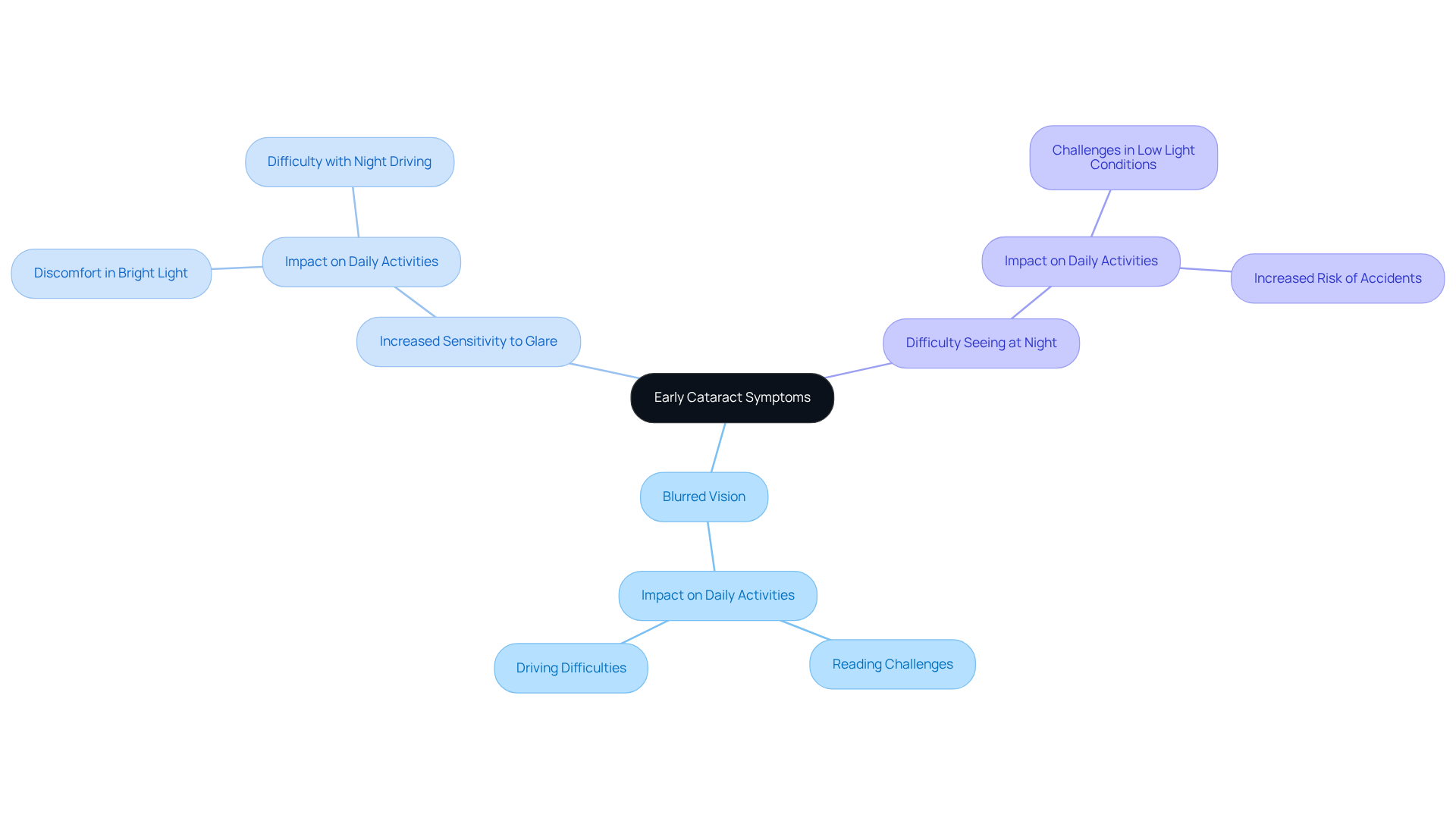
Blurred Vision: A Primary Indicator of Cataracts
Cloudy sight is often one of , and many individuals describe their experience as if they are looking through a misty pane. This visual distortion occurs when the lens of the eye becomes clouded, scattering light and hindering its clear passage to the retina. As a result, you might find it challenging to see clearly, making everyday activities like reading, driving, or recognizing faces more difficult.
We understand that this can be concerning. Studies indicate that approximately 65.2 million people worldwide are affected by , with over 80% experiencing moderate to severe sight impairment. By the age of 80, around 70% of Americans will encounter lens opacities, highlighting the condition’s prevalence among older adults.
If you notice that your vision is becoming increasingly unclear or if you frequently find that your eyeglass prescription changes without improving your sight, it’s important to reach out to an to assess for . , including like the (LAL) available at Northwest Eye. This innovative lens allows for personalized adjustments even after surgery, significantly enhancing your quality of life by potentially reducing or eliminating your need for glasses.
are essential for maintaining your eye wellness, especially since lens opacities can develop in individuals as young as 40. Remember, we are here to help you through this process, ensuring you receive the care and support you deserve.
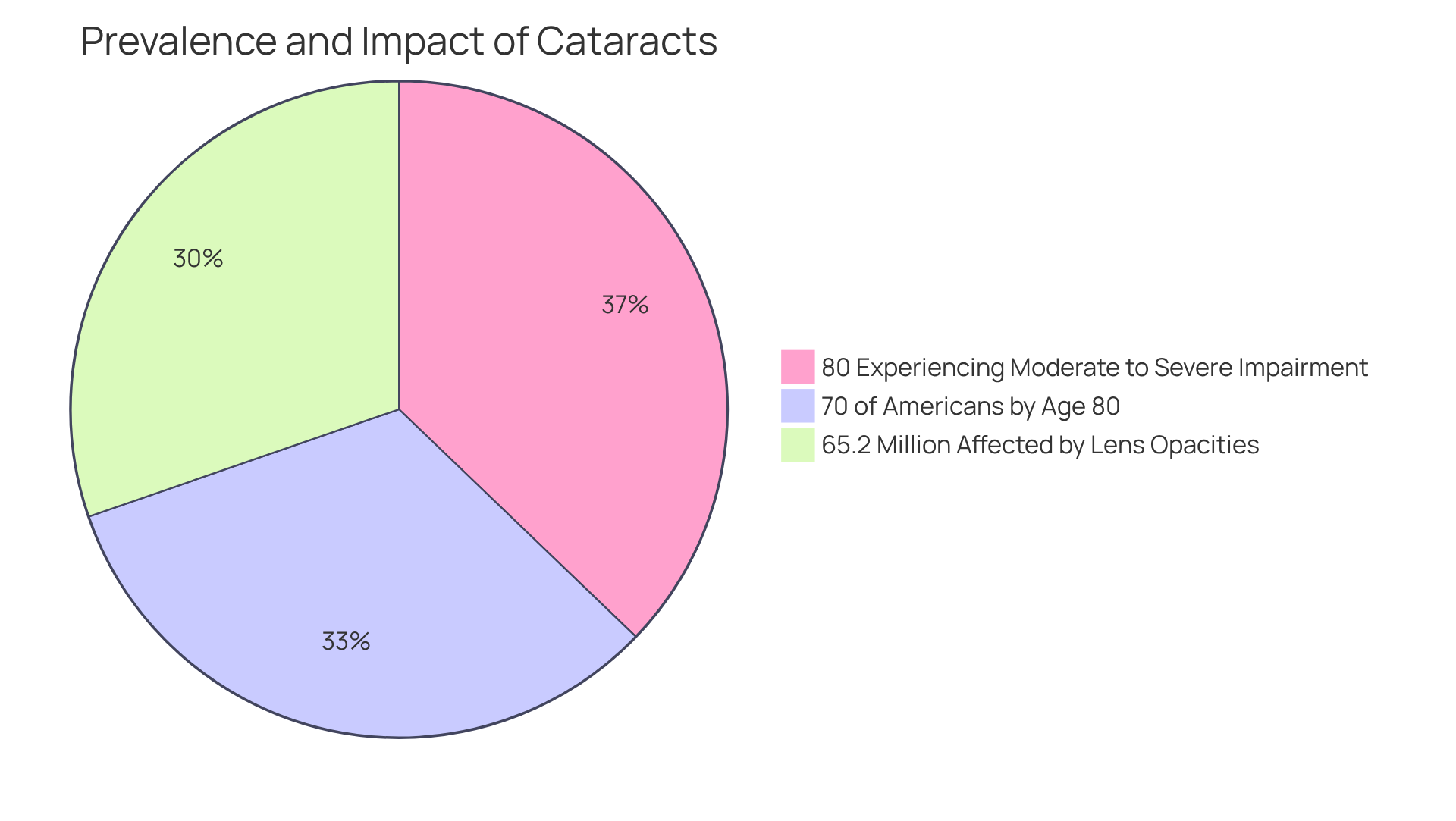
Sensitivity to Light: Navigating Discomfort from Cataracts
Heightened is a common concern for many individuals dealing with . We understand that this condition can lead to discomfort in bright environments, making everyday activities challenging. Patients often share that and glaring, especially when driving at night, which can significantly impact their quality of life. This may lead you to squint more often or even avoid well-lit spaces altogether.
To help alleviate these effects, consider:
- Wearing sunglasses that block 100% of UVA and UVB rays
- Using hats with brims when you are outdoors
For those contemplating , at Northwest Eye offers a personalized solution that can help manage light sensitivity after surgery. The LAL allows for adjustments to be made post-surgery, enhancing your vision for various lighting conditions and correcting both nearsightedness and farsightedness.
During the adjustment period, it is essential to wear UV protective goggles to achieve the best outcomes. If you notice an increase in light sensitivity or find yourself adapting your lifestyle to avoid bright conditions, these may be [cataracts symptoms](https://esterooptics.com/blog/insight-into-cataracts-symptoms-and-treatment-options), and we encourage you to consult professional for a thorough evaluation. Together, we can explore personalized treatment options, including , to support your vision and comfort.
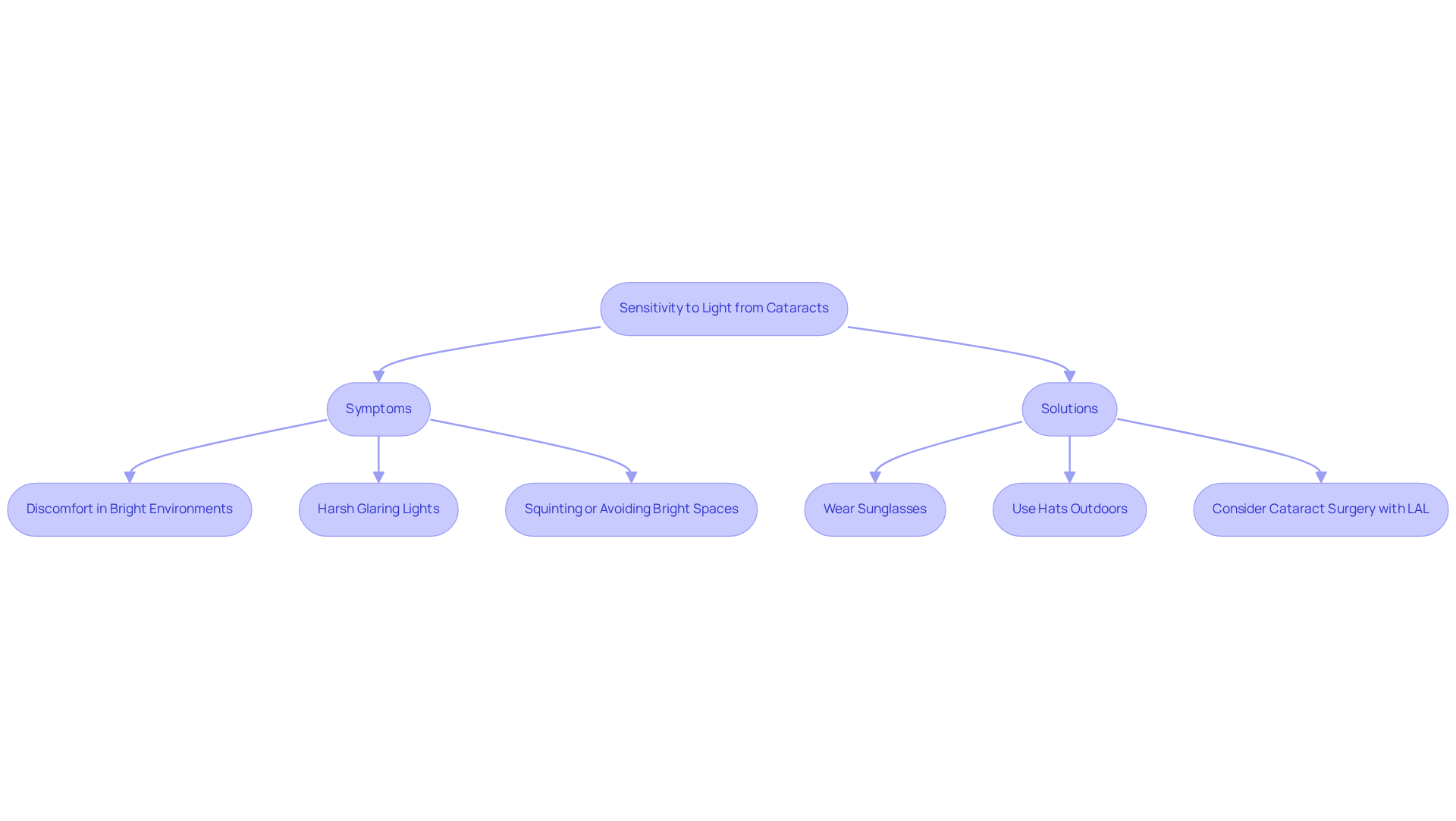
Poor Night Vision: Recognizing Deteriorating Sight Due to Cataracts
can significantly affect your night vision, and many patients express their struggles with . This impairment often manifests as and blurred sight, making it challenging to distinguish objects when the lights are dim. It’s common for individuals experiencing cataracts symptoms to perceive , which can complicate . These halos appear as bright circles surrounding light sources, and glare sensitivity is also prevalent, often requiring increased light for reading.
Studies indicate that about 50% of individuals with lens opacities experience difficulties seeing at night. This highlights the importance of recognizing these signs early. If you notice a decline in your ability to see at night or experience , we understand how concerning that can be. It’s essential to for a thorough evaluation.
are crucial for monitoring your eye health and addressing any concerns promptly. At Northwest Eye, we are here to help you through this process. We offer advanced solutions such as the (LAL), which allows for customized vision correction during eye surgery, ensuring the .
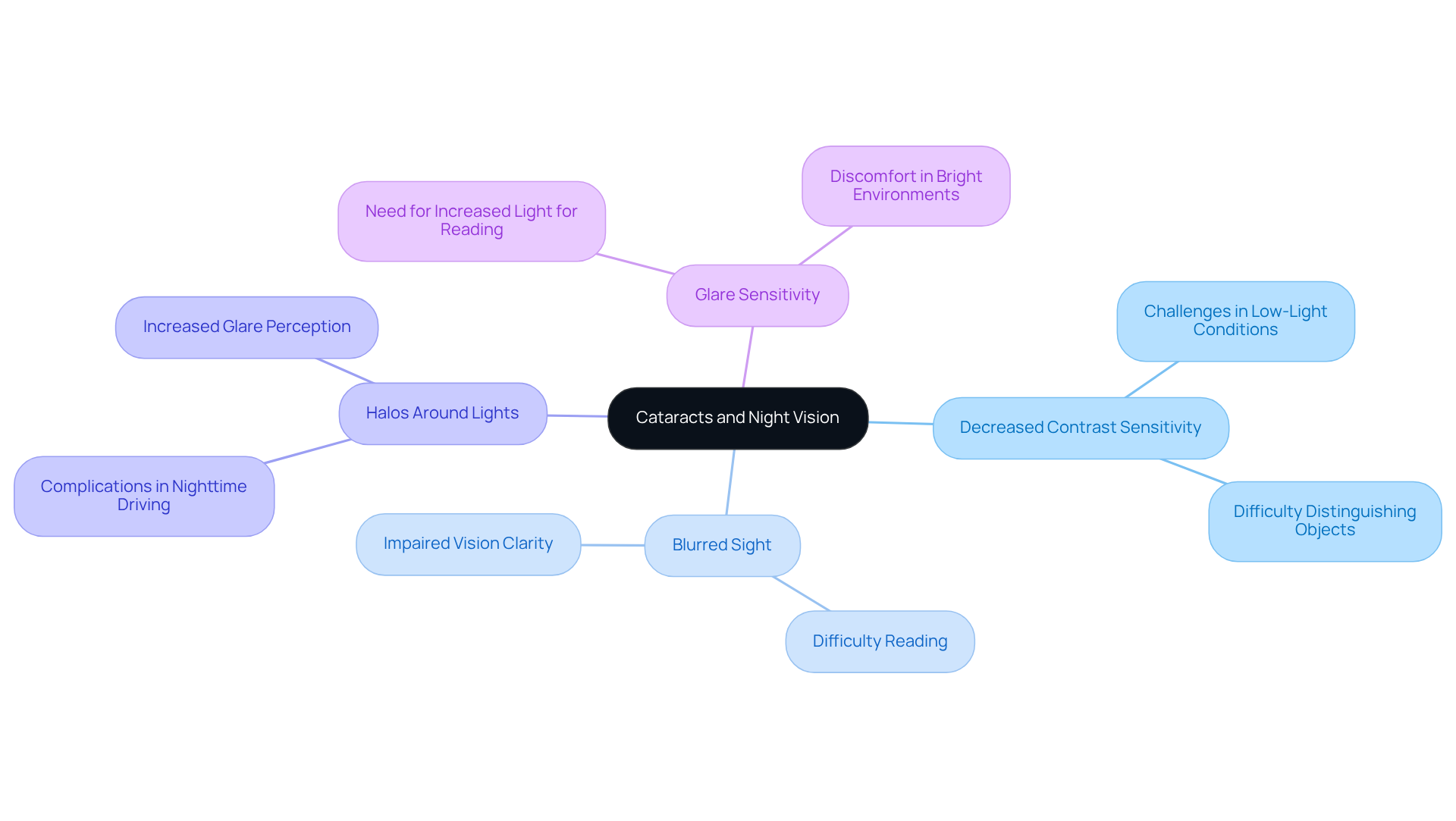
Faded Colors: Understanding Changes in Vision with Cataracts
As lens opacities advance, many individuals notice that make their favorite colors appear duller or less vivid. This change is a natural response to cataracts symptoms, which include the and alters . We understand that this can be concerning; research shows that approximately 50% of patients with experience cataracts symptoms, which makes it challenging to distinguish between hues. If you notice that your favorite colors seem washed out, it’s important to for a thorough evaluation of cataracts symptoms.
The on color perception extends beyond aesthetics; it can affect everyday tasks and your overall quality of life. As one specialist noted, ‘, extending their impact beyond aesthetics to daily activities.’ This highlights how color distortion can influence everything from appreciating art to essential tasks like driving and coordinating outfits. are crucial in managing these changes effectively, and we are here to help you through this process.
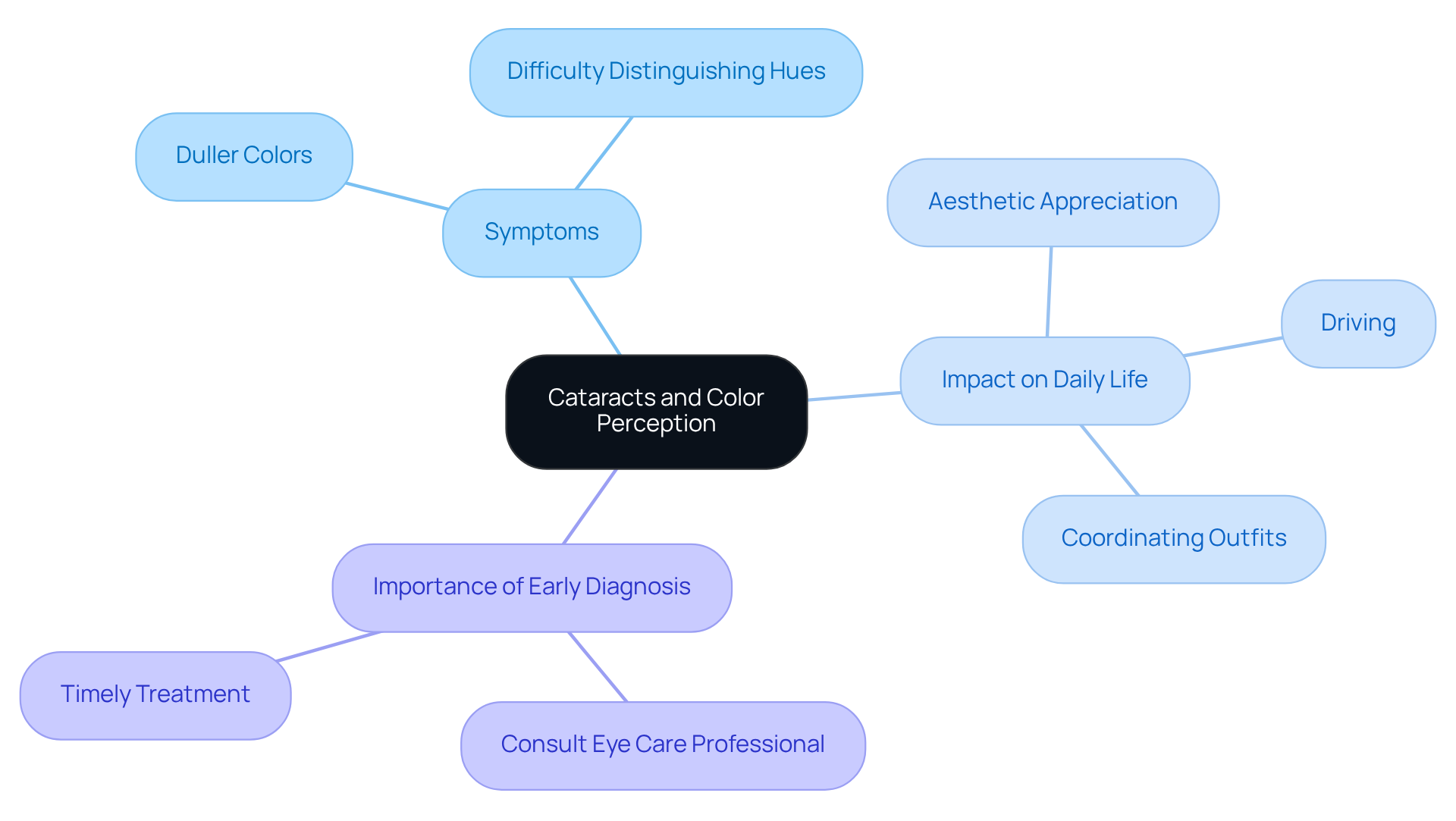
Double Vision: A Serious Cataract Symptom to Address Promptly
Experiencing , also known as diplopia, can be quite concerning. often occur when lens opacities distort the light entering the eye. We understand that this symptom can be alarming, and it’s important to address it quickly, as it may indicate that is progressing. Recent findings show that about 6.8% of patients undergoing experience , with the average age of these individuals being around 72.5 years.
It’s common to feel worried about , which frequently relates to cataracts symptoms caused by lens opacification. This can also stem from refractive issues like nearsightedness, farsightedness, presbyopia, or astigmatism, along with other ocular conditions. If you notice double vision or unclear sight—especially if it persists when one eye is closed—it’s crucial to seek an assessment from an . We are here to help you through this process.
Untreated diplopia and can lead to serious health issues and complicate the management of eye conditions, significantly impacting daily activities. Early detection and intervention are essential for maintaining your . As Dr. Michael Shumski highlights, recognizing the cataracts symptoms, such as double vision and unclear perception, is vital for prompt care. If you notice any symptoms, please schedule an to ensure that your vision health is prioritized.
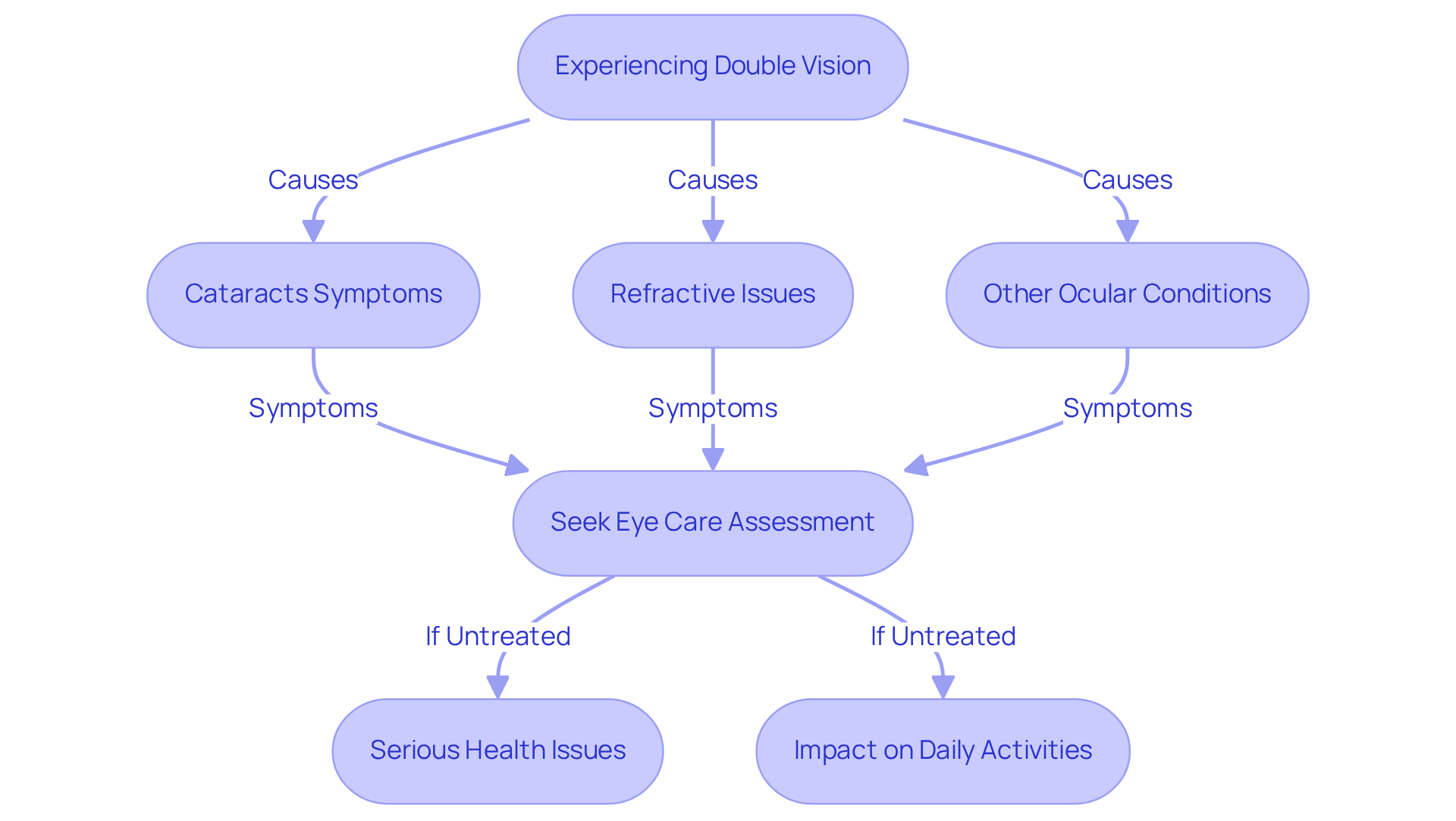
Halos Around Lights: A Disturbing Cataract Symptom
Noticing can often be concerning, especially at night. This phenomenon typically indicates due to lens opacity caused by light scattering as it passes through a cloudy lens. We understand that this can make or navigating well-lit areas quite challenging.
While halos can sometimes be a normal response to bright lights, they may also indicate , such as cataracts symptoms or uncorrected refractive errors. If you find yourself experiencing halos around lights, it’s essential to for a thorough evaluation.
At Northwest Eye, we are here to help you through this process. We offer like the (LAL), which allows for customized vision correction during eye surgery, ensuring the for our patients. Our specialized care and tailored are designed to meet your unique , providing you with the support you deserve.
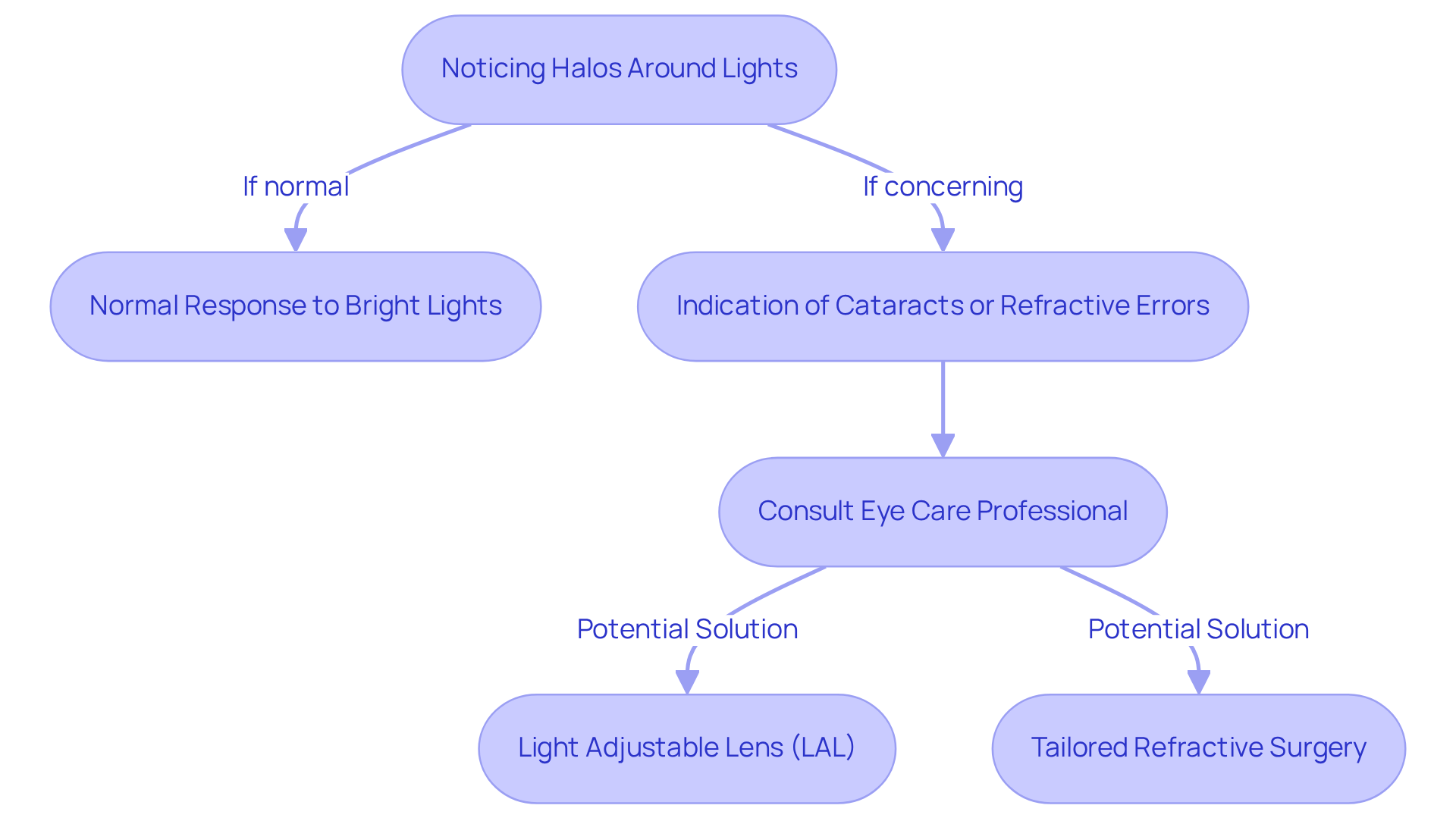
Changes in Prescription Lenses: A Sign of Cataract Development
Regular adjustments in your eyeglass prescription may suggest the beginning of lens opacification. We understand that this can be concerning. As progress, they disrupt how light is concentrated on the retina, leading to fluctuating sight and blurred perception. This may arise from refractive errors or indicate the existence of cataracts. Other conditions, such as diabetic retinopathy and , can also contribute to blurred sight. It’s common to feel uncertain about these changes.
This condition often leads to cataracts symptoms including:
- Difficulty with night vision
These symptoms can necessitate more frequent . Research indicates that approximately 50% of individuals will develop cataracts by age 75, with this figure rising to 70% by age 80. Regular eye examinations are crucial for monitoring these changes, allowing for .
of about 90%, resulting in significant enhancements in individuals’ quality of life. By remaining alert and seeking advice from , you can improve and tackle cataract-related concerns efficiently. We are here to help you through this process. Additionally, utilizing patient education resources, such as the , can empower you to understand your conditions better and seek timely medical intervention.
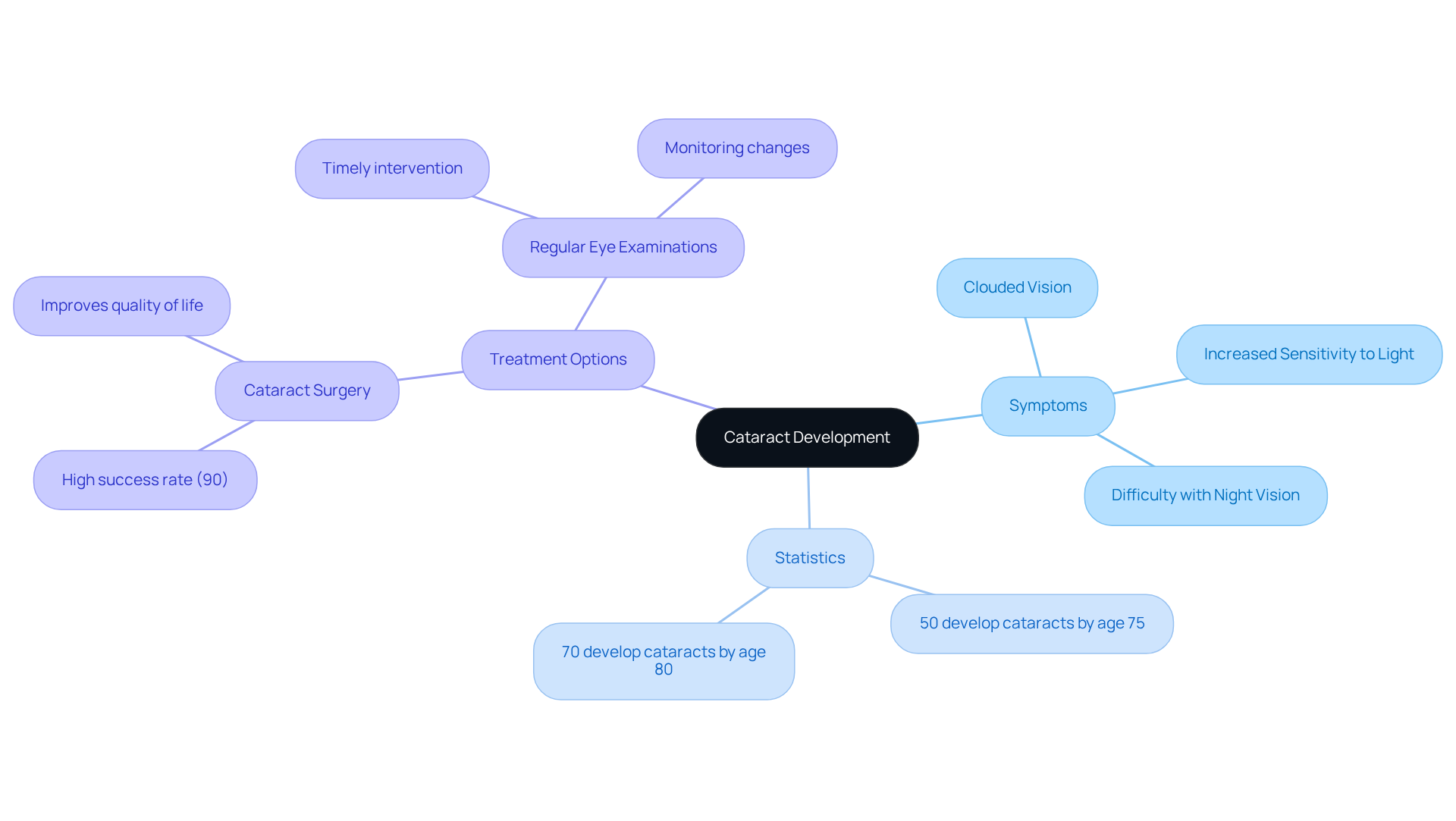
Regular Eye Exams: Essential for Early Detection of Cataracts
are crucial for the early discovery of . We understand that many may feel anxious about , but these allow eye care experts to recognize initial indications of lens formation. Studies show that people over 60 should undergo thorough eye examinations each year, especially since age is a significant risk factor for lens clouding. If you have additional risk factors, such as diabetes or a family history of eye conditions, it’s even more important to adhere to this recommendation.
The most recent guidelines for eye screening in 2025 suggest that individuals in their 40s and 50s should have eye examinations every 2-4 years. Meanwhile, those in their 20s and 30s may arrange exams every 5-10 years. We know that understanding signs such as can be concerning, as they may suggest along with lens opacities, diabetic retinopathy, , or macular degeneration. By prioritizing , you can facilitate timely intervention, potentially preventing and enhancing your overall eye health.
We are here to help you through this process. today to ensure your eye health is monitored by professionals who care.
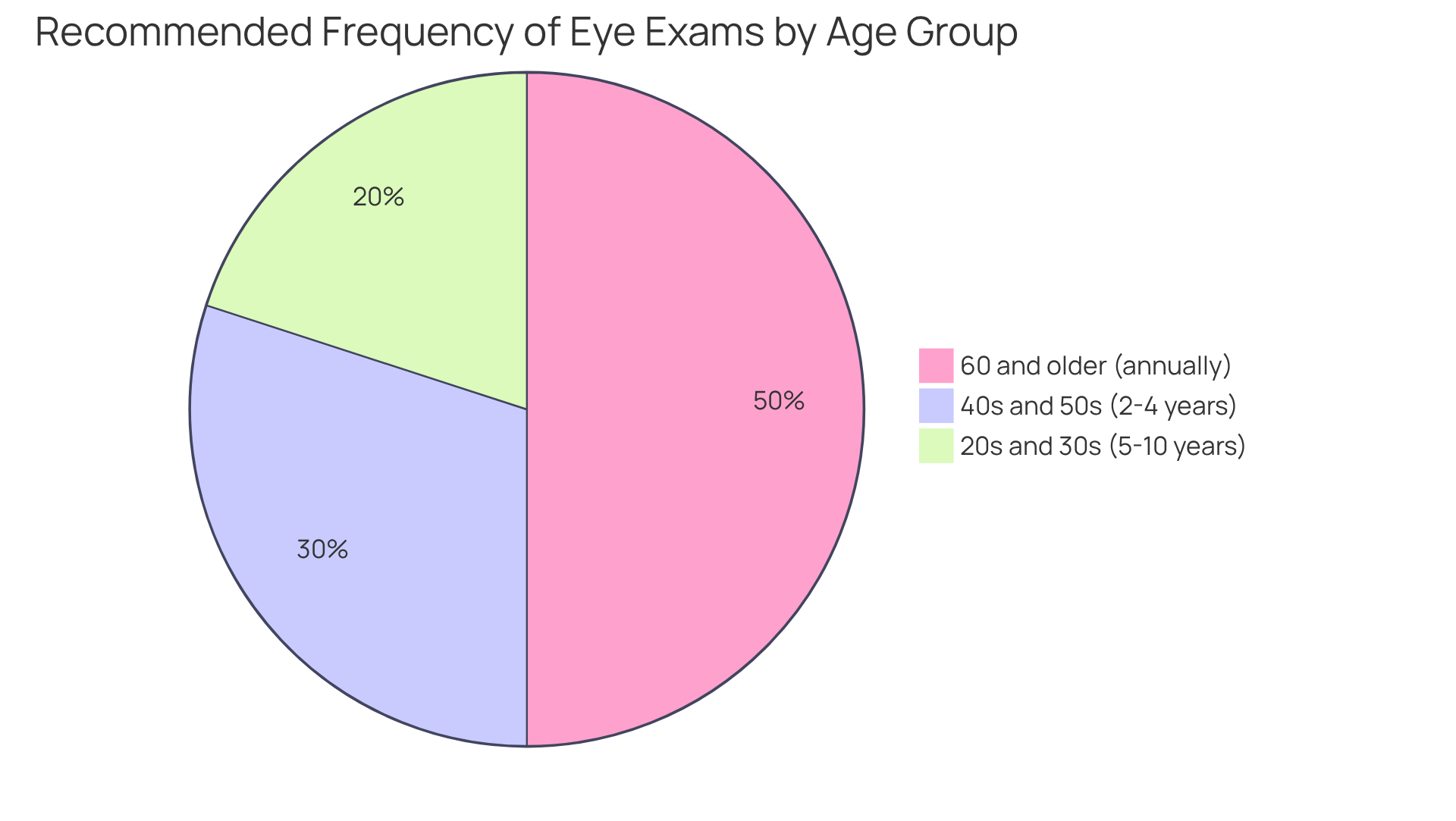
Consult Eye Care Professionals: Taking Action on Cataract Symptoms
Experiencing that relate to can be concerning, and we understand how important it is to address these feelings. Prompt consultation with an eye care expert is essential. can significantly and help preserve your vision.
Research indicates that many individuals with cataracts postpone seeking professional assistance, often leading to further deterioration of their condition. , our dedicated team prioritizes and expert guidance, ensuring that you receive the attention you need to effectively address .
Patient testimonials highlight the . Many individuals have noted enhanced sight and an improved quality of life after prompt treatment. By recognizing the cataracts symptoms and acting swiftly, you can take proactive steps toward and enjoying clearer vision. We are here to help you through this process, ensuring you feel supported every step of the way.
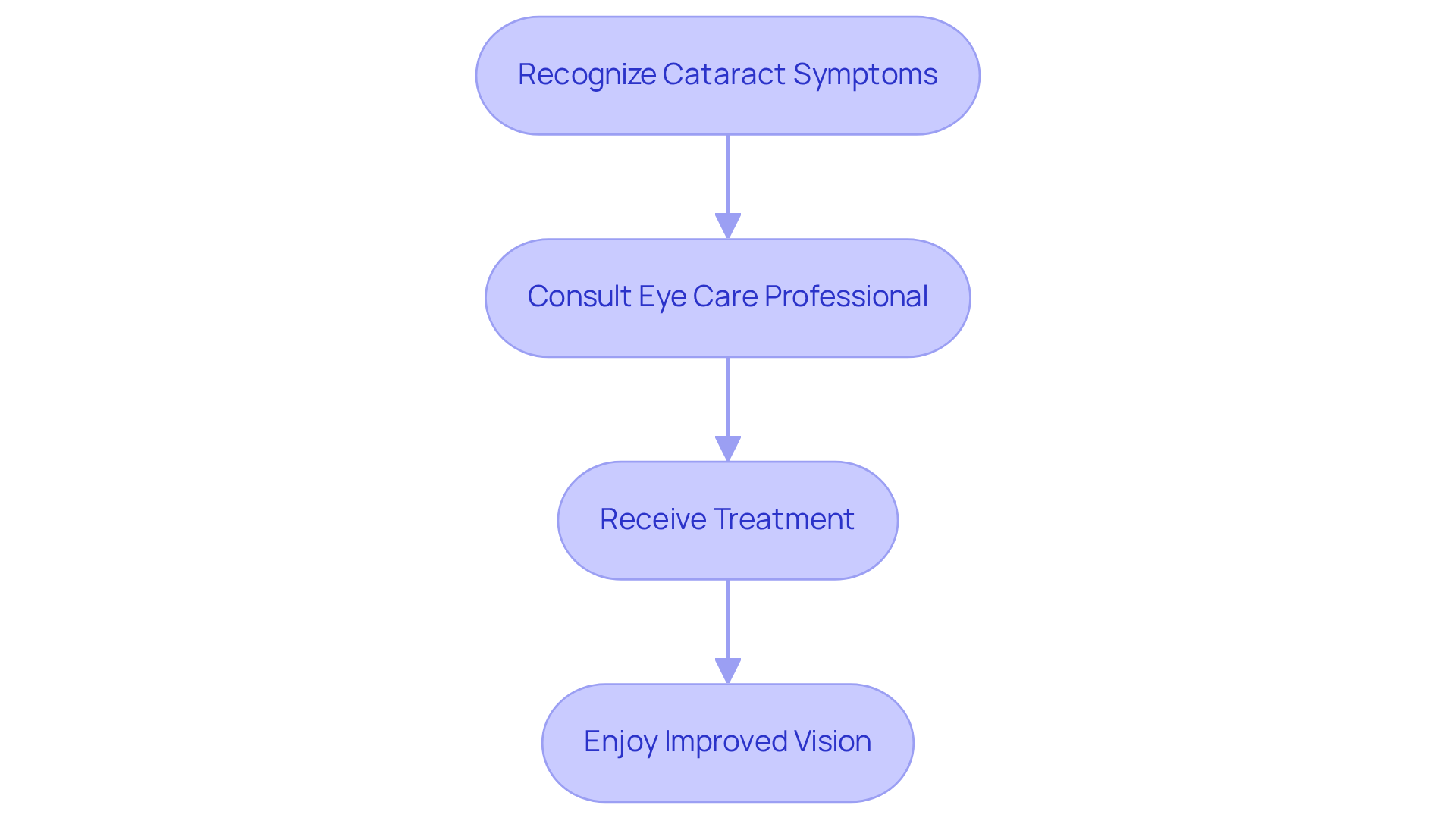
Conclusion
Recognizing the early symptoms of cataracts is essential for preserving your vision and maintaining your quality of life. We understand that noticing changes such as blurred vision, increased sensitivity to light, and shifts in color perception can be concerning. By being aware of these signs, you can take proactive steps to seek timely intervention. This awareness not only aids in early diagnosis but also significantly enhances the effectiveness of the treatment options available to you.
Throughout this article, we’ve highlighted key symptoms of cataracts, including:
- Poor night vision
- Halos around lights
- Double vision
Each of these indicators serves as a crucial signal that should prompt you to consult with eye care professionals. Early detection and intervention can lead to significantly better surgical outcomes, with many patients experiencing improved vision following appropriate treatment.
The significance of regular eye exams cannot be overstated. These check-ups are vital for the early identification of cataract symptoms. We encourage individuals, especially those over 60 or with additional risk factors, to prioritize these appointments to ensure your eye health is monitored effectively. Taking action upon noticing any of the discussed symptoms is imperative; by doing so, you can safeguard your vision and enhance your overall well-being. It’s common to feel apprehensive, but remember, we are here to help you navigate the journey toward clearer vision and an improved quality of life.
Frequently Asked Questions
What are the early symptoms of cataracts?
Early symptoms of cataracts include blurred vision, increased sensitivity to glare, and difficulty seeing at night.
Why is it important to recognize early cataract symptoms?
Recognizing early cataract symptoms is crucial for seeking prompt treatment, which can improve quality of life and lead to better surgical outcomes.
How common are cataracts among older adults?
By the age of 80, around 70% of Americans will encounter lens opacities, indicating the prevalence of cataracts among older adults.
What does blurred vision indicate regarding cataracts?
Blurred vision, often described as looking through a misty pane, occurs when the lens of the eye becomes clouded, making everyday activities like reading and driving more challenging.
What should I do if I notice changes in my vision?
If you notice your vision becoming unclear or if your eyeglass prescription frequently changes without improvement, it is important to consult an eye care professional for assessment.
What innovative treatment options are available for cataracts?
Advanced treatment options include the Light Adjustable Lens (LAL), which allows for personalized adjustments post-surgery, potentially reducing or eliminating the need for glasses.
How does sensitivity to light relate to cataracts?
Heightened sensitivity to light is a common symptom of cataracts, causing discomfort in bright environments and making activities like night driving challenging.
What can I do to manage light sensitivity caused by cataracts?
To manage light sensitivity, consider wearing sunglasses that block 100% of UVA and UVB rays and using hats with brims when outdoors.
What should I do if I experience increased light sensitivity?
If you notice an increase in light sensitivity or find yourself avoiding bright conditions, consult an eye care professional for a thorough evaluation and personalized treatment options.






